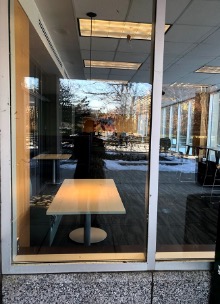Hello! I’m Gail Vallance Barrington. I teach Qualitative Research and Mixed Methods in Program Evaluation online for Michigan State University. The first assignment used to be a dry, uninformative memo describing students’ evaluation experience, career goals, and course expectations. A 2019 AEA presentation by Lloyd & Mackey convinced me that Photovoice might offer a more personal introduction. The results have been compelling, giving me a bird’s eye view into student’s lives[1]. COVID has only intensified that perspective and my teaching has changed as a result.
Cool Trick:
Students are asked to:
- Use a smartphone or camera to take three photos that capture the challenges and benefits of being an on-line student during a pandemic.
- Share photos with a partner or group, discuss the SHOWed questions, and select one photo for submission.
- Prepare a brief PowerPoint, reporting group outcomes, and noting changes to personal interpretation due to the discussion.
Hot Tips:
The research method Photovoice was developed by Wang & Burris. It has three goals:
- Enable people to record and reflect their community’s strengths and concerns.
- Promote critical dialogue and knowledge about important community issues through group discussion of photographs.
- Reach policymakers.
An essential component is the SHOWed Method. The photographer and discussants must discuss five questions about each image and what is portrayed. They try to achieve consensus.
Hershberg et al described using Photovoice in a community college setting. Their useful ideas helped me transform the method for online instruction.
Lessons Learned:
The photographs are revealing. They capture some of the issues, anxieties, and emotions that students have experienced in this disrupted time. Lessons are:
- Photovoice reveals the world through students’ eyes. It gives the lens to the students as other assignments do not, shifting perspective and power.

(Sarah Kuang)
- It builds cohesion. As an early course experience, it increases class collaboration and engagement. Student partnerships are positive, often maintained for other assignments.
…it was almost an icebreaker for us to speak on a relatable topic yet speak to our differences.
-Melissa Yzaguirre

…the discussions allowed us to share more of our thoughts about the online learning – the frustrations and the positives – and see that our experiences were not solitary.
-Nate O’Connor
- It has a generative effect. Attractive and approachable, students want to use it in future projects.
I can see myself using Photovoice in the future, especially for evaluations that aim to understand the narratives of the participants….
-Julia Mahoney
- It changed my perspective. Themes like loneliness, isolation, impact on family, and reliance on technology have emerged. Often my assumptions are shaken, and new avenues of thought open.
- I used to think, “Why can’t they follow instructions?” I was not accounting for students’ emotional needs. Now I’ve added a short video with assignment instructions to address anxieties that may inhibit processing written instructions.
- I send an email to acknowledge receipt of each assignment as it is submitted.
- I allow students to revise and resubmit assignments as needed.
- When students are unclear about course concepts, I offer them a private Zoom call.
- My understanding of community of practice has changed from an after-graduation phenomenon to a within-class one. I work to foster collaboration, and positive interaction.
- Each term I prepare a composite presentation of students’ photos for university administrators, visual evidence of the on-line graduate student experience. Feedback has been positive.
The American Evaluation Association is celebrating TOE TIG Week with our colleagues in the Teaching of Evaluation Topical Interest Group. The contributions all this week to aea365 come from our TOE TIG members. Do you have questions, concerns, kudos, or content to extend this aea365 contribution? Please add them in the comments section for this post on the aea365 webpage so that we may enrich our community of practice. Would you like to submit an aea365 Tip? Please send a note of interest to aea365@eval.org. aea365 is sponsored by the American Evaluation Association and provides a Tip-a-Day by and for evaluators. The views and opinions expressed on the AEA365 blog are solely those of the original authors and other contributors. These views and opinions do not necessarily represent those of the American Evaluation Association, and/or any/all contributors to this site.
[1] PSY884 students have given permission to share their photos and comments.
